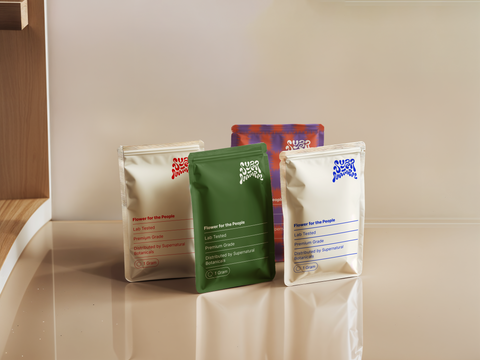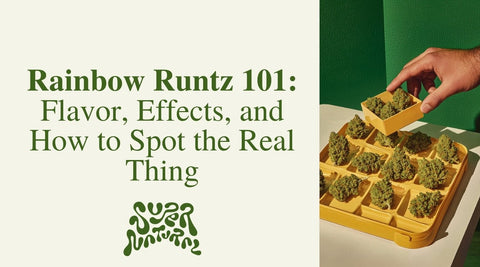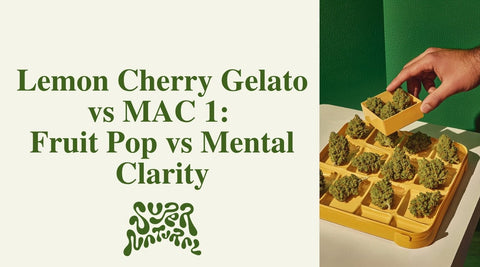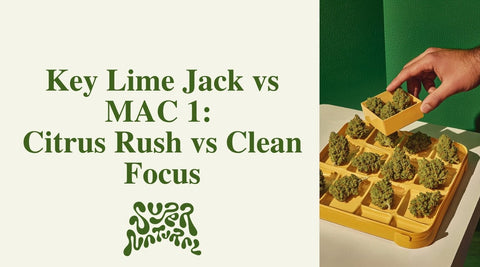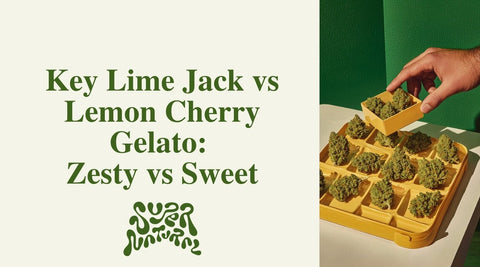
If you’re smoking THCa flower, you’re inhaling whatever’s in that bud. Cannabis pulls heavy metals straight from the soil, water, and air. It doesn’t care whether it’s absorbing minerals or industrial waste.
That makes it powerful as plant medicine, but also risky when brands skip proper testing.
Looks can’t tell you if it’s clean. Neither can smell or taste. Heavy metals don’t warn you before they settle in your lungs or blood. And no, your plug didn’t “flush” anything out. These toxins stick around.
The consequences aren’t theoretical. People are getting sick. Here’s what we’re talking about:
-
Lead causes cognitive issues and long-term developmental damage
-
Cadmium harms your lungs, kidneys, and bones
-
Arsenic is a known carcinogen and neurotoxin
-
Mercury damages the nervous system and builds up in body tissue
At Stay SuperNatural, we test for all of them. Every single batch. No exceptions. Most brands don’t. They use "lab tested" as a marketing line while avoiding full-panel analysis. If the COA only shows potency, it doesn’t prove the flower is safe. It proves the brand is cutting corners.
This article breaks down how metal contamination happens, how real testing works, how to spot fake or outdated COAs, and which strains are actually clean.
You’ll walk away knowing exactly what to look for and why Stay SuperNatural doesn't play games with your health.
How Heavy Metals Get Into Your Weed?
Cannabis is what scientists call a hyperaccumulator, which means it naturally pulls elements from its environment into its tissue. That includes nutrients you want, but also toxins you definitely don’t.
And unless a grower is actively testing and controlling for those toxins, your flower could be carrying more than just terpenes and trichomes.
Cannabis Is a Hyperaccumulator
Cannabis absorbs whatever is in the soil, water, or air around it. That’s a gift when the growing environment is clean and controlled. It’s a serious problem when it’s not.
Even when labeled organic, soil can still hold trace metals from past agricultural use, groundwater contamination, or nearby industrial activity.
Heavy metals don’t break down or disappear over time. They sit in the soil and wait for the next root system to come along and soak them up.
And once metals are absorbed, there’s no way to remove them from the plant. You can’t flush them. You can’t rinse them off. They’re locked in and carried through to the final product.
Five Risk Factors That Make Contamination Worse
Many cultivation practices increase the risk of heavy metal contamination, even when the flower looks pristine. Here are some of them.
-
Overuse of chemical fertilizers
-
Unregulated or contaminated water sources
-
Metal-heavy processing equipment used post-harvest
-
Grow sites located near industrial zones or highways
-
Outsourcing flower from third-party farms without safety audits
Can legal THCa flower be contaminated even if the COA says 'Pass'?
Yes. Especially if the lab only tested for potency, faked the report, or used old data. In the next section, we’ll break down how to spot a fake COA and what real testing looks like.
Inside the Lab: How Heavy Metals Get Detected
To know if your THCa flower is actually clean, you have to look inside the testing process. Lab reports are only as good as the equipment and standards behind them.
Plenty of brands wave a Certificate of Analysis around like it proves something, but if that COA comes from cheap methods or low-sensitivity tests, it tells you almost nothing.
Real testing for heavy metals requires precision at the parts-per-billion level, and very few brands invest in that level of accuracy.
Before we dive into each method, here’s a snapshot of how the main testing systems compare across sensitivity, speed, sample handling, and cost.
|
Testing Method |
Sensitivity |
Speed |
Sample Destruction |
Cost |
|
ICP-MS |
Ultra-high |
Medium |
Yes |
$$$$ |
|
ICP-OES |
High |
Fast |
Yes |
$$$ |
|
AAS |
Moderate |
Slow |
Yes |
$$ |
|
XRF |
Low to Moderate |
Very Fast |
No |
$ |
Inductively Coupled Plasma Mass Spectrometry (ICP-MS)
This method is considered the gold standard for cannabis testing. ICP-MS can detect metals at parts per trillion, making it the most sensitive option available. It uses a plasma torch to atomize the sample, then a mass spectrometer to analyze the ions.
It’s precise, multi-element capable, and the go-to method for regulatory compliance in many markets. Because of its ultra-high resolution, it’s ideal for detecting even trace levels of cadmium, arsenic, lead, and mercury.
Inductively Coupled Plasma Optical Emission Spectroscopy (ICP-OES)
ICP-OES is slightly less sensitive than ICP-MS but much faster. It measures the light emitted by ionized atoms in the plasma, allowing for rapid multi-metal analysis. While not quite as fine-tuned as ICP-MS, it’s still reliable for routine cannabis testing.
For small-batch producers that need trustworthy results quickly, this is a solid option. It’s also what many labs working with Stay SuperNatural use to maintain speed without sacrificing accuracy.
Atomic Absorption Spectroscopy (AAS)
AAS has been around for decades and remains common in agricultural and pharmaceutical testing. It’s more limited than ICP methods, typically focused on one element at a time. It’s also slower and slightly less sensitive, which means it might miss ultra-trace contamination.
Still, it’s better than skipping testing altogether. Some cannabis labs use a variant called Graphite Furnace AAS for increased sensitivity, especially for lead or cadmium.
X-Ray Fluorescence (XRF)
XRF is the fastest and least expensive option on this list. It doesn’t destroy the sample, which is great for high-value materials. The trade-off is sensitivity. XRF often fails to detect ultra-low concentrations of metals that matter in cannabis safety.
It’s occasionally used for initial screenings but should never be the final word on a COA. If a brand relies on XRF alone, that’s a red flag.
If a company claims their product is “clean” but can’t tell you which method their lab used, that’s your cue to walk away.
Interpreting the Certificate of Analysis
Lab reports are supposed to provide peace of mind. But if you don’t know how to read a Certificate of Analysis, you’re relying on trust alone. Some brands offer vague “Pass” or “Fail” summaries without any context, while others show you real data. The difference matters.
A true COA should reveal exactly what was tested, in what amount, and how the results compare to accepted safety thresholds. Here's how to read the numbers that actually protect you.

The Actual Numbers That Matter
A proper COA will list the exact concentration of each heavy metal. These values should be measured in parts per million or billion and compared against safety cutoffs. For inhalable products like flower or vapes, these are the maximum levels you want to see:
-
Lead should be below 0.5 ppm
-
Arsenic should be below 0.2 ppm
-
Cadmium should be below 0.2 ppm
-
Mercury should be below 0.1 ppm
If your COA just says “Pass” and gives no values, you don’t really know what you’re inhaling.
How to Spot a Fake or Outdated COA
Even if a COA looks official, a closer inspection can reveal red flags. Some documents are recycled from previous batches or edited to remove inconvenient results. Real transparency includes:
-
A visible batch number and test date
-
Listed detection limits for each element
-
A test date within the past 6 months
-
A dedicated section for heavy metals, not just potency
Why do some lab reports skip heavy metals? Because federal rules for hemp-derived THCa only require THC potency testing. Most brands take advantage of that. Stay SuperNatural doesn’t.
THCa Deserves Full Testing Too
You deserve THCa flower that meets the same standards as legal THC cannabis. Many brands stop at potency testing only. The 2018 Farm Bill requires checking Delta‑9 THC levels, but that’s it.
Mold, pesticides, and heavy metals tests remain optional for hemp-derived THCa. That gap leaves space for contamination to slip through, even when a label claims compliance.
Most Brands Test for Potency Only. That’s Not Enough
Potency alone gives no indication of safety. Impurities like mold spores, pesticide residues, or trace amounts of lead and mercury can be present without any regulatory requirement to report them. Brands can legally skip testing for heavy metals, and many do just that.
It means a COA focused only on cannabinoids doesn’t guarantee purity. For inhalable products, testing for contaminants matters just as much as potency.
SuperNatural Does Full‑Panel Testing on Every Batch
SuperNatural stands apart. Every strain goes through ISO‑certified third‑party labs with full-panel testing. That includes potency, mold, pesticides, mycotoxins, and heavy metals. Customers can request complete reports for each batch.
Every release meets internal standards that exceed federal rules. You get a transparent record of what you’re consuming, not vague labels or checkboxes.
Now let’s highlight some standout strains that prove our process works:
Key Lime Jack

Key Lime Jack is a sativa-dominant hybrid buzzes with citrus and gas energy. It’s lab-tested down to the parts‑per‑billion level across all heavy metals, meaning the numbers all fall well below safety thresholds.
Lemon Cherry Gelato

Lemon Cherry Gelato is a balanced hybrid that delivers dreamy, euphoric effects and a refreshing aroma of lemon and cherry. Lab results show zero detectable levels of heavy metals across the full panel.
Black Velvet

Black Velvet is a calming hybrid that brings a bright-balanced buzz with citrus notes. It has passed every contaminant test, from mold to mycotoxins, and shows no signs of metal content in its COA.
These strains offer more than flavor or effects, they showcase SuperNatural’s full transparency and commitment to delivering clean THCa flower that exceeds what most customers expect or brands offer.
Don’t Gamble with Health, Smoke Tested Only
Heavy metal contamination isn’t rare, and it’s not limited to cheap weed. It shows up when brands treat testing as a checkbox instead of a responsibility. Real testing means every batch, full panel, nothing skipped.
That’s how you protect people. That’s how you build trust.
Stay SuperNatural works with ISO-certified labs, shares real data, and holds every grow to a standard most brands avoid. If it doesn’t pass, it doesn’t ship. No exceptions. That’s what clean cannabis means here.
Check out what’s on deck at staysupernatural.com/collections/thca-flower.

